By The Numbers
It took me awhile to begin to get a sense of what the phrase “numbers match(ing)” meant in discussions of these cars. This page is here both to summarize what i have found on the many useful Oldsmobile-related websites i have perused and to show the numbers for this particular car.
Gratitude
I am in debt to a whole fleet of folks who have put up web pages and/or posted in Olds fora. Having viewed so many pages in the last few days and having not kept good records, this list is necessarily incomplete. Here are some of the sites or pages i found most useful:
- 442 Bro
- Ultra High Compression: 442 Restoration and Information
- 442.com Newest Internet Archive Wayback Machine capture that works for me
- Deciphering Your 1967 Oldsmobile Cowl Tag, some parts useful for 1965 Newest Internet Archive Wayback Machine capture that works for me
- GM Build Codes Newest Internet Archive Wayback Machine capture that works for me
- OldsVIN: The Postwar Oldsmobile VIN Decoder
- 1965 Chevelle Protect-O-Plates: These don’t match those for Olds, yet the month letters appear to correspond perfectly. Without this page, i still would have no clue about that Y on the Protect-O-Plate.
- Ted’s Oldsmobile Page Newest Internet Archive Wayback Machine capture that works for me
This Car’s Numbers
Given that this is a one-owner car, the numbers should match. Yet, with years of repairs plus restoration, one cannot count on that. Let’s have a look:

The numbers on the original sales order
Comparing with the booklets photo below, we see that the dealer Stock No. has been stamped onto both the Owner Protection Plan and the Convertible Top booklets. Note how the date of sale appears to be the 21st., yet the Protect-O-Plate and the Owner Protection Plan booklet both show the 23rd. Also, the Stock No. looks like 7y66, yet looking at the numbers stamped on two of the booklets, 7266 is much more likely.
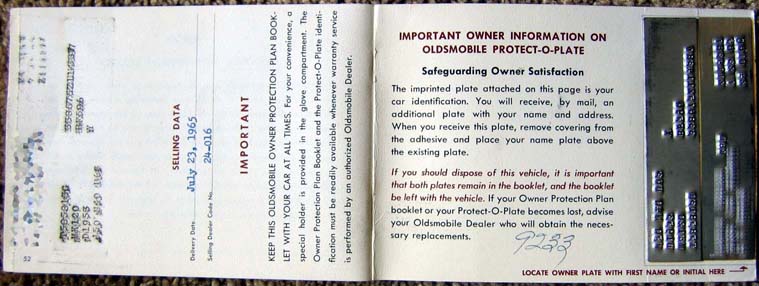
Protect-O-Plate page of Owner Protection Plan booklet
Notice how the Delivery Date and Selling Dealer Code Number, typed separately into the booklet, match those parts of the Protect-O-Plate (closeup below) itself. The address information has been fuzzed out for privacy reasons. I have no information regarding the meaning of the 9233 number… definitely not my father’s writing.
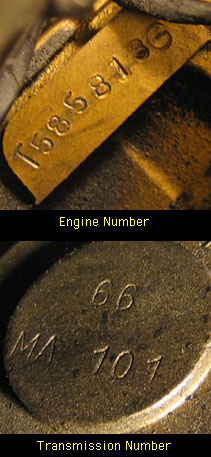
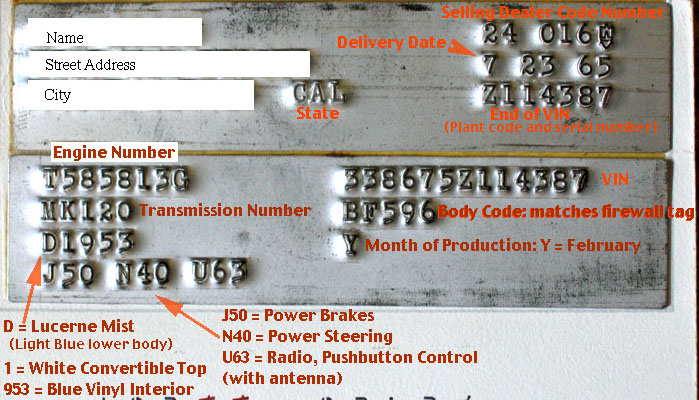
Protect-O-Plate, flipped around and annotated in Photoshop
Here i have flipped the normally reversed type on the Protect-O-Plates so that we may read them directly. As noted in the booklet text in the photo above this one, there are actually two plates:
- The car information Protect-O-Plate that comes with this booklet
- The owner plate, created by the dealer and mailed out subsequently to be pasted into this booklet
Starting with the pasted-in owner plate, we note that the selling dealer code matches that typed into the preceding page of the booklet. The interesting symbol following the numeral 6 has been identified on non-Olds sites (yes, the symbol there differs) as a brand mark. The following line has the date of delivery, which again matches what is typed into the Owner Protection Plan booklet. The bottom line on the right has the end of the VIN, with the plant code (Z=Fremont, California) and the serial number. My guess is that this information is there to verify whether this pasted-in plate matches the car description plate, and maybe for tracking this plate with the correct car, owner, and dealer through the creation and mailing process.
Moving to the very interesting and informative car information Protect-O-Plate, the first number in the upper-left is the engine ID number as stamped on the engine. It is easy to see that the Protect-O-Plate number exactly matches the number stamped on the engine. The 442.com Engine Code Numbers Decoded page Newest Internet Archive Wayback Machine capture that works for me points out that the T represents a 330 cu. in. V8 and the G represents High Compression (10.25:1). I was never able to find the two-letter code on the oil filler tube. As it is known that the engine is a 330 with a 4-bbl carburetor, high-compression, automatic transmission, and no air conditioning, the code should be QN.
The Protect-O-Plate code directly beneath is the transmission number… we see that those numbers do not match. There is a straightforward explanation for the lack of match: the transmission case was replaced by Jay’s Automatic Transmission Specialists on 20 August 1976. They apparently used a 1966 case. For those who are interested, other sites note that the 66 (in this case) is the last two digits of the model year (1966 for this replacement case), MA is the transmission model code, and 101 is a production sequence number. The original case would have been marked 65 MK 120, per the Protect-O-Plate.
Continuing in the left column going downward, D1953 is a concatenation of information which also shows up on the Fisher body tag:
- D= Lucerne Mist exterior body color
- 1= White convertible top color (non-convertibles would likely have a letter here if the top color does not match the lower body color)
- 953= Blue Vinyl interior
The bottom line in the left column contains three accessory codes. What i find interesting is that there are many more than three accessories listed on the sales order, all or nearly all of which have RPO codes. Further, there are two codes which appear on the Fisher body tag, neither of which show up here. My best guess is that the three items listed (N40 power steering, J50 power brakes, U63 “deluxe” radio) are more customer-significant and/or price-significant options than many of the others.
Looking at the right column of this same Protect-O-Plate, the first line is the full VIN, which naturally matches the VIN plate on the driver’s door pillar (photo forthcoming). The breakdown of the VIN is accurately discussed on several sites listed above. Quick summary:
- First 3: GM Division (Oldsmobile)
- 38: Series (Cutlass)
- 67: Body Style (2-door convertible)
- 5: Last digit of model year (1965)
- Z: Production Plant (Fremont, California)
- 114387: Serial number
Next line, right column: BF= Fremont, California plant code as listed on the Fisher body tag (Body Fremont?). 596 is the production sequence number on the same Fisher body tag.
Bottom line, right column: the single letter Y. This was messing me up for quite awhile, looking like some accessory code. Nope… notice that there is no month of production information, so far, on this Protect-O-Plate. That is exactly what that Y is. Y= February was the month of production of this vehicle. Because i have not seen this substantiated elsewhere on Olds sites, i now present my evidence.
If one looks at the 1965 Chevelle Protect-O-Plates page and writes down the date information there, the following pattern emerges:
- R= August
- T= June
- W= April
- X= March
Now we will leverage off this Chevelle information. Fill in the gaps and one sees that the year starts with Z and counts alphabetically backwards. I hesitate to speculate later in the year than August, since we go from T in June to W in April, which leaves both U and V for May (and i do not know which was used). There may be other “skippages” in the sequence as it works through to December.
As is about to be discussed below, the clearly documented Fisher body tag date code for this one-owner vehicle is the 3rd. week of February. And, the VIN-matching Protect-O-Plate shows the lone letter Y. And Y would match the sequence deduced from the Chevelle data. I feel confident that this position of a 1965 Oldsmoblie Protect-O-Plate represents the month of vehicle manufacture. I welcome others’ thoughts and contributions here or on any Olds forum.
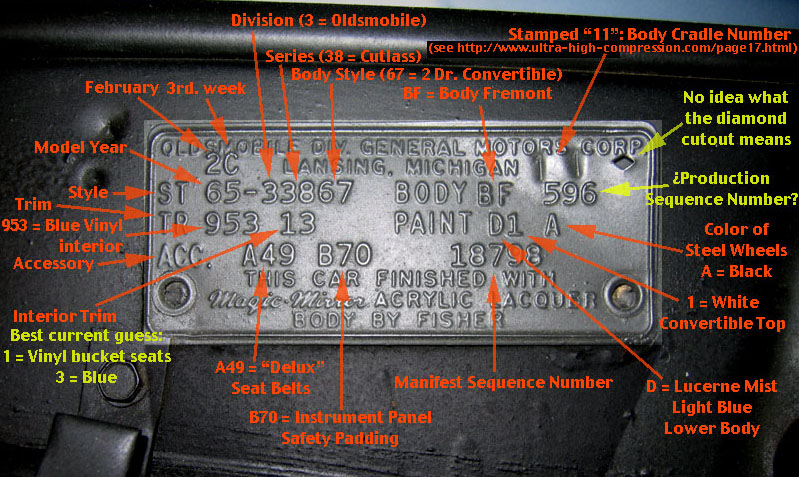
Body Tag, a.k.a. Cowl Tag annotated in Photoshop
Plenty of information on this typical Fremont, California Fisher body tag! And, fortunately, well documented by others (other than my thoughts on the second trim number). I’m mostly going to let the photo annotations do the talking. We see the 2C date code, indicating production of the body during the 3rd. week of February.
As far as the second TRim number(13)’s meaning, here is my evidence and my thoughts:
- The Trim line on the Sales Order clearly shows “Trim” as “13”
- The information on Deciphering Your 1967 Oldsmobile Cowl Tag Newest Internet Archive Wayback Machine capture that works for me and the number 13 mostly matches the known facts of this car.
I have not even read any theories regarding possible meanings of the diamond cutout in the upper-right corner of these Fisher body tags.
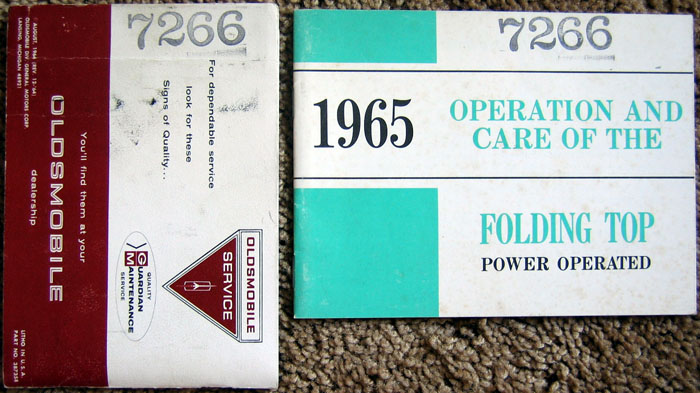
Dealer stock number stamped on Owner Protection Plan and Convertible Top booklets
These numbers match each other and the Albertson Oldsmobile stock number on the Sales Order. No guesses on meaning. Probably used so the items would not get lost while the vehicle was on the lot (which this one was).
 World O’ Automotiveness
World O’ Automotiveness